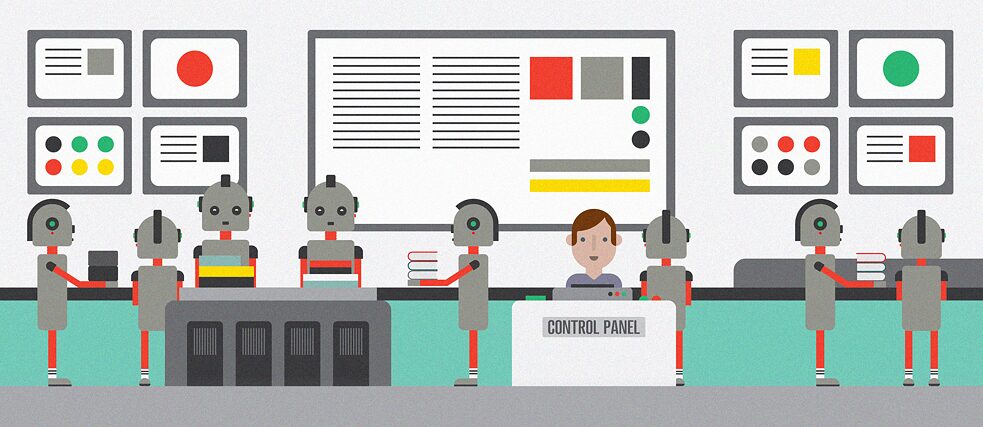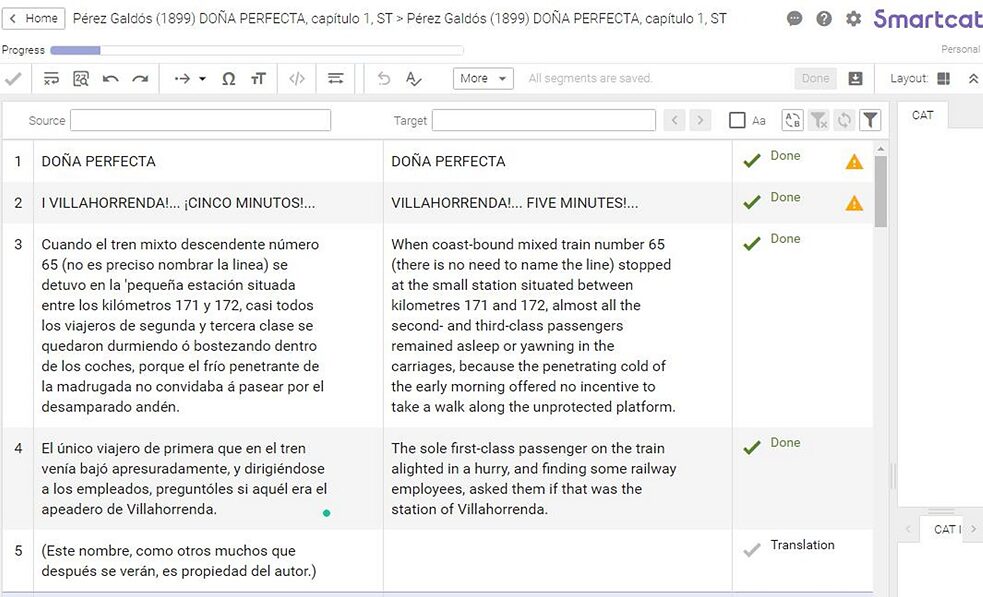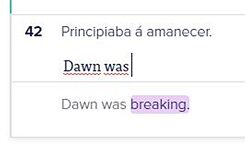Digital Translation Tools
Can Artificial Intelligence Help Literary Translators?

How is literary translation different from other forms of translation? To oversimplify a little, non-literary translation such as commercial, legal, medical etc. tends to focus on the meaning of a text, while literary translation focuses almost equally strongly on the style of the text.
By Roy Youdale
Literary style concerns not only what is said, but how it is said. The literary critic Terry Eagleton suggests that literary writing ‘is the kind of writing in which content is inseparable from the language in which it is represented’. For example, the two sentences below basically mean the same thing but the way this is expressed is quite different, as is the reading experience involved.
- She picked a purple bluebell from the ground.
- Purple was the colour of that sign of spring she plucked from the earth, the bluebell.
So a literary translator has to take account of style as well as content, which involves making linguistic choices and it is often said that no two translators will translate the same text in exactly the same way. So how do literary translators go about trying to recreate both the meaning of a text and what they perceive to beits effects on the reader? Basically by looking for patterns of language used in the original and attempting to recreate them in another language, a process I call ‘creative reverse engineering’.
A.I. and the detection of linguistic patterns
Human beings are both creatures of habit and individuals. Just as we always walk in a particular way, different from other people, and have unique fingerprints, so when we write we use both conscious and unconscious patterns of expression. These can be used to identify us as writers and become important factors when someone translates our writing into another language. Some of these linguistic patterns are relatively easy to spot. If a writer uses a lot of slang or goes in for big words like discombobulated, this is easily noticed. However, there are important aspects of literary style which affect the experience of the reader which are not so easily detected. These include things like sentence length, the use of punctuation and repetition. If we are unaware of the existence and importance of these linguistic patterns we cannot attempt to recreate them in a literary translation.What if artificial intelligence (AI) could help translators identify linguistic patterns used by a writer? The good news is that it can, and in increasingly sophisticated ways. Software such as Sketch Engine can, with a couple of mouse clicks, list all the words in a text according their frequency of occurrence; produce an analysis of sentence length (both overall average sentence length and a breakdown of the number of sentences consisting of 2, 3, 4, etc. words); list n-grams (repeated sequences of 2, 3, 4, etc. words) by length and frequency of occurrence; and analyse lexical richness (the number of different types of words expressed as a proportion of the total number of words), amongst other things. The text-visualisation programme Voyant Tools can display various linguistic features of a text visually, showing word frequency as a word cloud and the frequency of usage of individual words and phrases across a text as a graph. The text analysis programme Coh-Metrix provides over 200 statistical measures of language use and readability with a single click.
Finding a variety of linguistic patterns in the original text to be translated is one thing, but having found them, how is the translator going to recreate them in another language? What if AI could do more than just analyse linguistic patterns prompted by the translator and actually do some translating on its own? Again, as anyone who has ever used Google Translate will know, the answer is that it can and in different ways. Another article in this dossier, ‘Artificial Intelligence and Literary Translation’, shows how fully automated neural machine translation (NMT) has been used to translate literature in the last few years. The article and the research it cites suggest that while fully automated literary translation has a long way to go before it can hope to match human translation, its use as a form of first draft which is then edited (‘post-edited’ in the jargon) by a translator is being taken more seriously. But there is another way in which AI can be used by the literary translator: to make real-time translation suggestions as they type.
A.I. and the convergence of two translation technologies
To understand this it is first necessary to briefly explain how computer-aided translation (CAT) software, used by almost all non-literary and a few literary translators, works. CAT tools, as these software programs are referred to, were developed in the 1960s and 1970s and have been available commercially since the 1980s. The technology at their heart is called the translation memory (TM). The idea behind this is that a translator should never need to translate the same sentence twice when it crops up again in a text. In other words, as a translator works their way through a document the program automatically stores everything that is translated, and when an already translated sentence is presented again for translation the program recognises this and offers the translator the translation s/he has already done, thus saving both time and energy and also helping to ensure consistency of translation, which is often very important. It has been shown that CAT tools work best on texts which are repetitive, linguistically regular and are written in fairly short sentences.The CAT tool user interface usually presents the text to be translated in the form of a table, broken up into sentences (or ‘segments’ as they are called), each occupying a single cell. This ‘source’ text as it is called appears in the left-hand column of the table, while the right-hand column provides empty cells into which the translation, or ‘target’ text, is typed, as shown here:
 Smartcat translation interface
| Roy Youdale | Smartcat | CC-BY-SA
In Smartcat, a free online CAT tool, a pane appears to the right of the columns shown in the screenshot in which automated TM suggestions appear, which the translator can accept or reject. In the early CAT tools all such suggestions were only taken from the database of the already translated segments in the current document. However, the range of sources of translation suggestions in CAT tools has increased very substantially since then. It is now possible to import a TM from one or more related translations into a CAT tool; to draw on, and also create, specialised glossaries (or ‘term bases’); and to search the TMs to see how individual words and phrases have already been translated, as well as complete sentences. A game-changer in this respect has been the incorporation of machine translation (MT) into CAT tools.
Smartcat translation interface
| Roy Youdale | Smartcat | CC-BY-SA
In Smartcat, a free online CAT tool, a pane appears to the right of the columns shown in the screenshot in which automated TM suggestions appear, which the translator can accept or reject. In the early CAT tools all such suggestions were only taken from the database of the already translated segments in the current document. However, the range of sources of translation suggestions in CAT tools has increased very substantially since then. It is now possible to import a TM from one or more related translations into a CAT tool; to draw on, and also create, specialised glossaries (or ‘term bases’); and to search the TMs to see how individual words and phrases have already been translated, as well as complete sentences. A game-changer in this respect has been the incorporation of machine translation (MT) into CAT tools.MT basically uses a computer to search and compare the words in a source text with very large databases (billions of words) of texts already translated into the target language. In addition to the translation of individual words, the computer searches for corresponding sequences of words or ‘strings’, a process known as ‘string matching’. With advances in the latest kind of machine translation, NMT, computers can now not only look for direct string matches but can also scan the context of each sentence, looking at the surrounding sentences. This helps to deal with problems of ambiguity that arise with words like ‘right’, for example, which can mean a direction, correct, fair or an entitlement. It is the ability of CAT tools to use MT databases well as TMs and term bases when making translation suggestions that shows AI in action.
Integration of MT into CAT tools
There are two main ways in which translation suggestions generated by the combined resources of TMs and MT databases are now built into CAT tools. The first involves the software coming up with a suggestion for the complete translation of the segment being worked on, i.e. a whole sentence. The translator can then accept the suggestion, reject it or edit it. This is often called the post-editing approach. The other way involves using interactive machine translation (ITM). Here the software uses the same range of resources but presents the results in real time in the form of suggested auto-completions, exactly like predictive texting. As translation researchers Anna Zaretskaya, Gloria Corpas Pastor and Miriam Seghiri explain: “The suggestions are computed each time a character is typed, and the user can accept them by pressing a special key or reject them by continuing typing. This way the system continuously adapts the suggestions while the user is typing,” effectively ‘learning’ as it goes.Here, we see this in operation in one of the newer CAT tools, Lilt.
 Real-time translation suggestion in Lilt
| Roy Youdale | Smartcat | CC-BY-SA
This has the potential to increase translators’ creativity by offering them translation solutions which they may not have come up with by themselves. On the other hand, some translators experience this system as applying pressure on them to accept the suggested auto-completion, thus actually limiting their creativity.
Real-time translation suggestion in Lilt
| Roy Youdale | Smartcat | CC-BY-SA
This has the potential to increase translators’ creativity by offering them translation solutions which they may not have come up with by themselves. On the other hand, some translators experience this system as applying pressure on them to accept the suggested auto-completion, thus actually limiting their creativity.
Literary translators and CAT tools
Most literary translators do not use CAT tools for their translations. They argue that such tools do not work for the kind of language found in literary texts and they are also often uncomfortable with a user interface which breaks up the text into isolated sentences, thus depriving them of the context of the paragraph, page or chapter which is so often needed when dealing with narrative. They also tend to reject the MT of literature, pointing to the poor quality of the output from programs like Google Translate, and arguing that in order to translate literature translators have to know much more than just the meaning of the words on the page. They also need to understand cultural, political and historical references, idiomatic expressions and everything that makes up what we call ‘real world knowledge’.Attitudes do seem to be changing, however, and younger literary translators in particular seem more willing to consider experimenting with CAT tools. While it is true that the benefit of not having to repeat the translation of whole sentences is usually much less of an advantage in literary translation where the degree of such repetition is often much lower, other features offered by CAT tools in principle apply equally well to all types of translation. These include the ability to:
- easily find your place in a translation after a break or moving away to look something up, making it less likely that you will miss out sentences in the translation, something which is surprisingly easy to do
- view your previous versions of each completed segment, reminding you of how you arrived at the current version and allowing you to revise it if necessary
- search the translation to see how you have translated a particular word or phrase before
- export a translation in different formats, such as a sentence-aligned table or a standard Word document.
Conclusion
[One definition of artificial intelligence is] the theory and development of computer systems able to perform tasks normally requiring human intelligence, such as visual perception, speech recognition, decision-making, and translation between languages.
Oxford Dictionary
It is appropriate to reflect on the current state of that balance.
Definitions:
- CAT (Computer-Aided Translation)
- ITM (Interactive Machine Translation)
- NMT (Neural Machine Translation)
- Text-Visualisation
- TM (Translation Memory)
- Word cloud
References:
Boase-Beier, J. (2010) Stylistic Approaches to Translation. 3rd edn. London and New York: Routledge.
Chan, S.-W. (2015) ‘Computer-aided translation: major concepts’, in Chan, S.-W. (ed.) The Routledge Encyclopedia of Translation Technology. London and New York: Routledge, pp. 32–67.
Eagleton, T. (2014) How to Read Literature. New Haven and London: Yale University Press.
Garcia, I. (2015) ‘Computer-aided translation: systems’, in Chan, S.-W. (ed.) The Routledge Encyclopedia of Translation Technology. London and New York: Routledge, pp. 68–87.
Lombardino, R. (2014) Why I Use A CAT Tool To Translate Books, eWordNews.
Melby, A. and Wright, S. (2015) ‘Translation Memory’, in Chan, S.-W. (ed.) The Routledge Encyclopedia of Translation Technology. London and New York: Routledge, pp. 662–677.
O’Hagan, M. (ed.) (2020) The Routledge Handbook of Translation and Technology. Abingdon and New York: Routledge. doi: 10.4324/9781315311258.
Prachi, K. ‘An Introduction to N-grams: What Are They and Why Do We Need Them?’
Rothwell, A. and Youdale, R. (forthcoming) ‘Computer-Assisted Translation (CAT) tools, translation memory and literary translation’, in Deane-Cox, S. and Spiessens, A. (eds.) The Routledge Handbook of Translation and Memory. London and New York: Routledge.
Ruffo, P. (2018) ‘Human-Computer Interaction in Translation : Literary Translators on Technology and Their Roles’, in Proceedings of the 40th Conference Translating and the Computer. London: AsLing, pp. 127–131.
Schiaffino, R. (2016) CAT tools and translation style, About Translation. Available at: https://www.aboutranslation.com/2016/04/cat-tools-and-translation-style.html.
Slessor, S. (2020) ‘Tenacious technophobes or nascent technophiles? A survey of the technological practices and needs of literary translators’, Perspectives. Taylor & Francis, 28 (2), pp. 238–252. doi: 10.1080/0907676x.2019.1645189.
Wasaty.pl (2019) ‘Literary translations with CAT tools’. October 20.
Youdale, R. (2020) Using computers in the translation of literary style: challenges and opportunities. London & New York: Routledge.
Zaretskaya, A., Pastor, G. and Seghiri, M. (2015) ‘Integration of machine translation in CAT tools: State of the art, evaluation and user attitudes’, SKASE Journal of Translation and Interpretation, 8 (1), pp. 76–88.
Comments
Comment